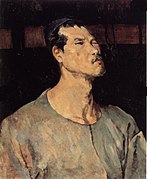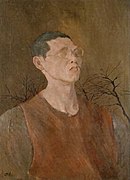Ai Mitsu
Ai Mitsu ( Japanese 靉 光 ; born June 24, 1907 ; died January 19, 1946 ), real name: Ishimura Nichirō ( 石村 日 朗 ), was a Japanese painter in the "western style" ( Yōga ) of the Shōwa period .
life and work
Ai Mitsu was in town Mibu in Hiroshima Prefecture was born as the second son of a farmer. His uncle in Hiroshima took him in as a foster son, where he attended high school. After graduating from school in 1922, he worked in a printing company. In 1924 he moved to Osaka, where he attended the private art school Tensaiga-juku ( 天 水彩画 塾 ) and now devoted himself to painting. From about this time he called himself Aikawa Mitsurō, which he later merged to "Ai Mitsu".
In 1925 he moved to Tōkyō, where he settled in the Taninaka district and continued his education at the “Pacific School of Western Painting” ( 太平洋 画 研究所 Taiheiyōga kenyūsho ). He was mainly influenced by contemporary French painting. In 1926 one of his pictures was accepted for the first time at the Nika exhibition ( 二 科 展 ), namely “Montparnasse Ikebukuro”. There he continued to exhibit pictures until 1935.
Ai Mitsu made friends with Hasegawa Toshiyuki ( 長谷川 利 行 ; 1891–1940) and Matsumoto Shunsuke and took on influences from Fauvism and Expressionism . From 1935 he took part in the "Exhibition of Independent Art" ( 独立 美術展 Dokuritsu bijutsu-ten ), where in 1936 his picture "Lion" ( し し Shishi ) was exhibited. After that, he only painted lions for two years. At the 8th exhibition of independent art in 1938, he exhibited the picture "Landscape with an Eye" ( 眼 の あ る 風景 Me no aru fūkei ), with which he won a prize and which made him known. During this time he traveled to Shanghai, then toured the northeast region of China, was interested in the classical Chinese art of the Song and Yuan periods , but also in surrealism .
In 1942 Ai Mitsu participated in the founding of the "group of new artists" ( 新人 画 会 Shinjin gakai ), together with Tsuruoka, Matsumoto, Asō Saburō ( 麻 生 三郎 ; 1913-2000) and others. The exhibitions of the group of new artists indicated a counter-position to the fascism ruling at the time. Pictures from this period are "birds" ( 鳥 Tori ), "self-portrait with hat" ( 帽子 を か む る 自 画像 Boshi o kamuru jigazō ), "self-portrait with branches" ( の あ る 自 画像 Kozue no aru jigazō ) and "self-portrait in white shirt" ( 白衣 の 自 画像 Hakui no jigazō ) During this time he visited Manchuria three times.
In 1944, shortly after completing his “Self-Portrait in a White Shirt”, Ai Mitsu was drafted into the military and died of malaria and amoebic dysentery towards the end of the Pacific War in early 1945 in Shanghai.
In 1945, when the atom bomb was dropped on Hiroshima, the pictures stored by Ai Mitsu there were lost.
Ai Mitsu will not be forgotten despite his short active time with his independent work in Japan. In 2007 the National Museum of Modern Art in Tōkyō dedicated a memorial exhibition to him.
photos
Remarks
- ↑ This picture was shown at the exhibition Japanese Painting in Western Style 1985 in the Museum for East Asian Art in Cologne.
- ↑ 白衣 literally means "white robe". This is often an attribute of the saints and scholars.
literature
- Japan Foundation (Ed.): Japanese Painting in the Western Style, 19th and 20th Centuries. Exhibition catalog, Cologne, 1985.
- Tazawa Yutaka: Biographical Dictionary of Japanese Art . Kodansha International, 1981. ISBN 0-87011-488-3 .
- Laurance P. Roberts: A Dictionary of Japanese Artists. Weatherhill, 1976. ISBN 0-8348-0113-2 .
Web links
Individual evidence
| personal data | |
|---|---|
| SURNAME | Ai, Mitsu |
| ALTERNATIVE NAMES | 靉 光 (Japanese, stage name); Ishimura Nichirō (real name); 石村 日 郎 (Japanese, real name) |
| BRIEF DESCRIPTION | Japanese painter |
| DATE OF BIRTH | June 24, 1907 |
| DATE OF DEATH | January 19, 1946 |






